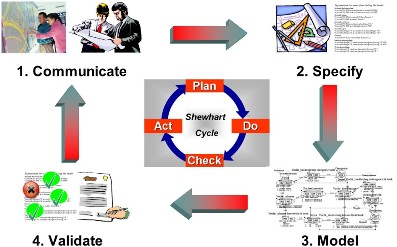Does experience help? No! Not if we are doing the wrong things
A first glance at the Information Management Frame (IMF; see figure 1 under Impressions) reveals that at the conceptual level there are no dividing lines between the pillars of application. At this level all relevant information is split into elementary facts, expressed in sentences that are devoid of any non-conceptual information or constructs. These elementary facts are exactly the same in every pillar.
In the IMF-approach (see figure 2 under Impressions) we start with Phase 1, the preparatory phase. In this phase we make a picture of the total user domain, to allow us to guard the cross-functional relations between different information processes. We split this domain into areas that can be handled separately in an evolutionary approach, and prioritize these areas so as to determine in what order we should handle these areas.
 In Phase 2 of the IMF-approach we do the actual data modelling for a chosen area, using Fact Oriented Modeling (FOM). To this end, we gather and design concrete examples of all relevant information in this area. Then, we verbalize all relevant fact types that can be seen in the concrete examples. This is done together with the business experts involved in their own language, which allows them to actually validate that the information they need is well understood by the modellers. For all formulated facts we determine the internal structure, based upon the business requirements indicated by the experts. As soon as all relevant facts in the concrete examples are verbalized, analyzed, and approved by the experts, a fully suitable information structure is derived from this conceptual model with an exact algorithm based on predicate theory. This way the logical structure of the obtained information model is completely driven by the verbalizations of the information (the precise semantics) and the prevalent constraints.
In Phase 2 of the IMF-approach we do the actual data modelling for a chosen area, using Fact Oriented Modeling (FOM). To this end, we gather and design concrete examples of all relevant information in this area. Then, we verbalize all relevant fact types that can be seen in the concrete examples. This is done together with the business experts involved in their own language, which allows them to actually validate that the information they need is well understood by the modellers. For all formulated facts we determine the internal structure, based upon the business requirements indicated by the experts. As soon as all relevant facts in the concrete examples are verbalized, analyzed, and approved by the experts, a fully suitable information structure is derived from this conceptual model with an exact algorithm based on predicate theory. This way the logical structure of the obtained information model is completely driven by the verbalizations of the information (the precise semantics) and the prevalent constraints.
Every good FOM-casetool is capable of regenerating all facts from the information model. This allows the experts to validate that the derived model contains precisely all necessary information, nothing more and nothing less. This implies that the approach of Fact Oriented Modeling can be illustrated as in the figure left. The design cycle starts with communication with the domain experts in their own natural language, and ends with complete validation of the final result by the very same experts. With that the cycle is closed. After this, the obtained information model can be implemented with confidence in a well-oiled machine, which is capable of rolling out all information desired to the end customers.